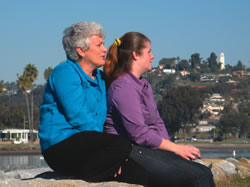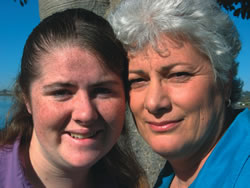

Turning around the tragedy of foster careBy Kristina Horton Flaherty By age 8, Patricia McKee had no place to call home. Her father had committed suicide. Her mother spent the rent money on drugs and got the family evicted. And after years of hunger and neglect, McKee was bounced around San Diego County to 23 different foster care placements and 14 schools.
But throughout the turbulent years, she could count on one person — Nancy Rosenberger, her court appointed special advocate (CASA) — for support, guidance and help navigating the system. Now McKee, at 18, is beating the odds. After “aging out” of the system, she moved into her own apartment, got a job at a bakery and began her first year of college on scholarships. She could not have done it, she says, without Rosenberger. “There were times when I didn’t care about me, but she did,” McKee said. “She will be there when I get married. She will be there when I have children. Most people have their dad walk them down the aisle; I will have Nancy.” For many foster youth, the picture is much different. Some 65 percent have nowhere to live when they age out of the system. Fewer than half graduate from high school. And while 70 percent of emancipating teens say they would like to go to college, less than 3 percent actually do. They suffer post-traumatic stress disorder at twice the rate of U.S. war veterans. Too many — lacking education, life skills and money — wind up homeless or in trouble with no one to call for help, advocates say. It is a disturbing picture that has captured the public spotlight in recent years, triggering scrutiny, new legislation and innovative initiatives. The California Young Lawyers Association (CYLA) has just joined the growing effort to turn the statistics around. Launching “Young Lawyers for Youth,” CYLA has begun recruiting young lawyer volunteers for two programs — one in San Diego, the other in San Rafael. In San Diego, volunteers will handle immigration and special education cases through the Foster Youth Advocacy Project at the San Diego Volunteer Lawyer Program (SDVLP). In San Rafael, volunteers at Marin Advocates for Children will help track down long-lost relatives and other adults who may provide stability and lasting connections for foster children. “One of our goals was to create opportunities for the young lawyer to personally connect with the foster children,” said Matthew Butler, CYLA’s representative on the State Bar Board of Governors. “The two programs obviously provide that opportunity on different levels.”
California’s foster care system currently oversees nearly 80,000 abused, abandoned and neglected children. Roughly 4,000 of them age out of the system each year, usually at 18. While more transitional housing programs (in some cases for youth up to age 24), independent living classes and scholarship programs have sprung up in recent years, the need still far outweighs the resources, advocates say. In his swearing-in speech this fall, bar President Jeff Bleich urged attorneys to start delivering some real help. “Today in one of the wealthiest and most powerful states in human history, 60 percent of the children leaving foster care will either be institutionalized, homeless or dead within five years,” Bleich said, “and we have only a handful of lawyers helping to stop this tragedy.” At Bleich’s request, CYLA took the lead. After canvassing existing programs statewide, CYLA leaders chose two and obtained a California State Bar Foundation grant to train volunteers. In addition, the CYLA Web site now features a statewide list of other organizations and initiatives seeking volunteer assistance for foster youth. Organizers say SDVLP’s Foster Youth Advocacy Project will give attorneys a chance to gain new skills under a supervising attorney’s guidance and help foster children as well. At the first training, volunteers will choose to handle special education cases or help foster children obtain legal status as lawful permanent residents. The volunteer attorney’s level of involvement will be tailored to his or her availability. But Dawn Davis, the SDVLP’s managing attorney, is hoping for something more. “We hope that they will take more of a mentoring role and become more involved with these kids,” she said. “My personal dream is to connect people with these kids and get them involved in a professional, mentoring kind of way.” In San Rafael, attorney volunteers will help launch a new Lifelong Connections program at Marin Advocates for Children. Volunteers will use “family finding” — a mix of case mining, Internet searches and a little detective work — to help find lasting connections for teenagers close to aging out of the system. The first training is tentatively slated for March. In recent years, more focus has been placed on establishing enduring connections between foster children and caring adults. There is a growing recognition, advocates say, that such connections — even when they do not lead to a new home — can make a crucial difference, particularly when a child ages out of the system. “These young people who have already suffered trauma that most of us can’t imagine are left to fend for themselves at 18 or 19,” said Robert Friend, director of the California Permanency for Youth Project. “Our vision is that no youth leave the California child welfare system without a permanent, lifelong connection to a caring adult.” An increasing number of children’s advocates and social workers nationwide are now using family finding to locate and build such connections. The effort, many say, is leading to more relative placements, cost savings and potential lifelong bonds for children. Marin Advocates for Children also runs the county’s Court Appointed Special Advocate (CASA) program. CYLA leaders hope that some attorneys will decide to make a greater commitment and become a CASA. CASAs are trained volunteers appointed by juvenile courts to spend at least one year (longer in some cases) as one-on-one advocates for foster children. Serving 43 counties in California, CASAs bond with a foster child and advocate for his or her interests in court and the community. Data suggests that children with CASAs are more likely to get needed services and wind up in a home outside the foster care system. Take Adam Bateham, for example. Shortly after his 17th birthday, his mother died and he and his sister landed in a group home in Orange County. While his sister soon moved to a foster home, Bateham, who was born without legs, languished at the group home for much longer. He finished high school and wanted to go to college, but his social worker discouraged him from making any plans until a foster home could be found. “I was watching TV and playing games for seven or eight months,” Bateham said. “And I was very angry.” When his attorney asked a judge to appoint a CASA, Bateham’s life changed. His CASA, a retired engineer, helped him arrange for college placement tests, apply to college and find a job. During a visit to Bate-ham’s old high school, the two ran into a counselor who offered Bateham a place to live. Today, Bateham is a college junior in a full scholarship program — and he still sees his CASA regularly. “You develop a relationship,” he said. “You kind of want to show them that you appreciate that, you know, and make them proud.” In California, fewer than one in 10 foster children get a CASA. (The rate is one in two nationwide.) “I think a lot fall through the cracks,” said Bateham, who now works as a peer mentor to foster youth. Nancy Rosenberger, a mother of four, has served as a CASA for some 30 children over the past 12 years. She has celebrated birthdays, bought a prom dress, listened to children’s troubles and fought for better schooling and home situations. When they turn 18 and head off on their own, she stays in touch. “I always think, ‘If it were my child, would I be happy with where they’re living, with their school?’” she said. “It’s frustrating because sometimes the perfect solution isn’t available.” Patricia McKee was 11 — one of seven siblings — when Rosenberger first met her. Since then, Rosenberger has followed McKee from foster homes to group homes and once to juvenile hall. She persuaded one school district to provide transportation so that McKee, despite moving, could stay at the same junior high school and continue playing the clarinet. She mentored McKee through the college application process. “There were plenty of times when I wanted to drop out of school,” McKee recalls, “but Nancy just made me realize that if I really wanted to succeed, I was going to need an education.”
Rosenberger, a CASA through San Diego’s Voices for Children program, believes that many foster children just need to be accountable to someone who cares. She knows she has an impact even when a situation does not turn out well. “I can still see what a difference I’ve made in a kid’s eyes,” she said. One boy “used to say I was the only one in his life who wasn’t paid to care about him.” Advocates say an overburdened, under-funded, reactive and secretive foster care system only heightens the need for one-on-one connections. In some counties, social workers handle 40 cases or more at a time, while dependency attorneys may carry caseloads of 600. Newly proposed budget cuts, too, have raised concerns. This spring, the Blue Ribbon Commission on Children in Foster Care, chaired by state Supreme Court Justice Carlos Moreno, will recommend ways of improving the courts’ performance, accountability and collaboration with other agencies serving foster children. A new advisory California Child Welfare Council will seek to create a more coordinated, collaborative system. Reforms have been enacted in recent years, but advocates say some laws are not being implemented at the county level. “Maybe where the focus needs to be in the next few years is getting those laws implemented,” said Bill Grimm, a senior attorney with the National Center for Youth Law. Attorney Jennifer Troia has seen such problems firsthand. Fresh out of law school, she volunteered as an education advocate for two boys living in a group home. Recent law requires schools to allow uprooted foster children to finish out the year in the same school, enroll in a new school immediately (even without their records) and receive partial credit for past work. But when one of the boys was moved to four different high schools and a juvenile hall school during his senior year, Troia found herself in a showdown with school officials. The teenager lost his chance to play football, attended night school to make up credits and worried that he would not graduate. Troia had to fight for the boy’s credits and his right to be admitted into school — every time. “I was on the phone with 12 different people, trying to get them to follow the law,” she said. One school official, she recalls, simply said, “So sue me,” and hung up. In the end, after many trips to school district offices and help from a few educators, she finally saw the boy graduate on time. “It took so much tenacity and legal knowledge on my part to get him through that,” said Troia, who still visits the teenager once a week. The experience also helped steer the course of her career. Troia went on to serve as California CASA’s director of advocacy and will soon begin working for the Assembly Committee on Human Services. “It was incredibly powerful,” she recalls, “to see the difference an individual can make.” To volunteerAttorneys interested in volunteering for the SDVLP Foster Youth Advocacy Project can contact James Simmons at james.simmons@sdcda.org. To volunteer for the lifelong connections project at Marin Advocates for Children, contact Juna Kim at jkim@vanlevylaw.com. For a statewide list of organizations seeking volunteers to assist foster youth, go to calbar.ca.gov/cyla. |
||||||||
|
||||||||

